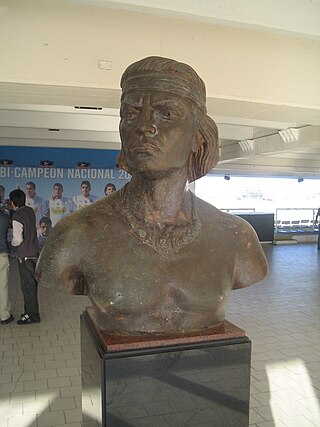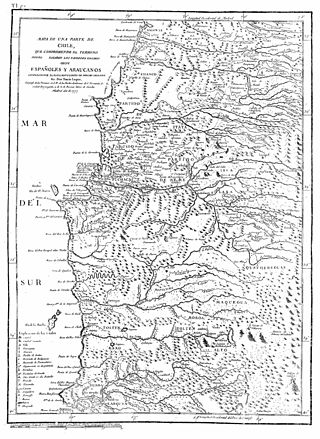Account of Garcilaso de la Vega
In a six-year campaign with an army that eventually rose to 50,000 men, the Inca general Sinchiruca [4] had subdued the regions of northern Chile, Copiapó, Coquimbo, Aconcagua, and the Maipo Valley around what is now Santiago. After securing the Maipo Valley, Sinchiruca sent 20,000 men down to the valley of the Maule River. The territory of the Picunche people inhabiting this last region south of Maipo Valley extended further to the south to the Itata River, and these people south of the Maipo Valley had refused to submit to the rule of the Inca and called on their allies south of the Maule; the Antalli, Pincu, and Cauqui to join in opposing these invaders. [5] This defiance gave them their distinctive name of Purumaucas from Quechua purum awqa meaning "savage enemy". The Spanish later corrupted the name into Promaucaes.
The Incas crossed the Maule River, and keeping their old custom, they sent messengers to require these Purumaucas to submit to the rule of the Inca or resort to arms. The Purumaucas had determined to die before losing their freedom, and responded that the victors would be masters of the defeated and that the Incas would quickly see how the Purumaucas obeyed. Three or four days after this answer, the Purumaucas and their allies arrived and camped in front of the Incas' camp with 18,000 - 20,000 warriors. The Incas tried diplomacy, offering peace and friendship, claiming they were not going to take their land and property but to give them a way to live as men. The Purumaucas responded saying that they came not to waste time in vain words and reasoning, but to fight until they won or died. The Incas promised battle the next day. [5]
The following day both armies left their camps and fought all day without either gaining an advantage, and both suffering many wounded and dead. At night they both retired to their positions. On the second and third day they fought with the same results. At the end of the third day of battle both factions saw that they had lost more than half their number in dead, and the living were almost all wounded. On the fourth day, neither side left their own camp, which had been fortified, as they hoped to defend them if their opponents attacked. The fifth and sixth days were passed in the same manner but by the seventh the Purumaucas and their allies retired and returned home claiming victory. [2] [6]

Colocolo was a Mapuche leader in the early period of the Arauco War. He was a major figure in Alonso de Ercilla y Zúñiga's epic poem La Araucana, about the early Arauco War. In the poem he was the one that proposed the contest between the rival candidates for Toqui that resulted in the choice of Caupolicán. As a historical figure there are some few contemporary details about him. Stories of his life were written long after his lifetime and display many points of dubious historical accuracy.
The Picunche, also referred to as picones by the Spanish, were a Mapudungun-speaking people living to the north of the Mapuches or Araucanians and south of the Choapa River and the Diaguitas. Until the Conquest of Chile the Itata was the natural limit between the Mapuche, located to the south, and Picunche, to the north. During the Inca attempt to conquer Chile the southern Picunche peoples that successfully resisted them were later known as the Promaucaes.

The Arauco War was a long-running conflict between colonial Spaniards and the Mapuche people, mostly fought in the Araucanía. The conflict began at first as a reaction to the Spanish conquerors attempting to establish cities and force Mapuches into servitude. It subsequently evolved over time into phases comprising drawn-out sieges, slave-hunting expeditions, pillaging raids, punitive expeditions, and renewed Spanish attempts to secure lost territories. Abduction of women and war rape was common on both sides.

Toqui is a title conferred by the Mapuche on those chosen as leaders during times of war. The toqui is chosen in an assembly or parliament (coyag) of the chieftains (loncos) of various clans (Rehues) or confederation of clans (Aillarehues), allied during the war at hand. The toqui commanded strict obedience of all the warriors and their loncos during the war, would organize them into units and appoint leaders over them. This command would continue until the toqui was killed, abdicated (Cayancaru), was deposed in another parliament, or upon completion of the war for which he was chosen.

The Battle of Tucapel is the name given to a battle fought between Spanish conquistador forces led by Pedro de Valdivia and Mapuche (Araucanian) Indians under Lautaro that took place at Tucapel, Chile on December 25, 1553. This battle happened in the context of the first stage of the Arauco War, named the "offensive war" within a larger uprising by Araucanians against the Spanish conquest of Chile. It was a defeat for the Spaniards, resulting in the capture and eventual death of Valdivia.
Battle of Peteroa was a battle in the Arauco War in 1556, in a plain beside a river in the Mataquito River valley, called Peteroa. The battle was between the Spanish forces of Pedro de Villagra, and Mapuche headed by their toqui Lautaro.
Promaucae, also spelled as Promaucas or Purumaucas, were an indigenous pre-Columbian Mapuche tribal group that lived in the present territory of Chile, south of the Maipo River basin of Santiago, Chile and the Itata River. Those to the north were called Quillotanes and Mapochoes by the Spanish colonists). They spoke Mapudungun, like the Moluche to the south, and were part of the Picunche tribe that lived north of the Itata River.
Ainavillo, Aynabillo, Aillavilu or Aillavilú, was the toqui of the Mapuche army from the provinces of "Ñuble, Itata, Renoguelen, Guachimavida, Marcande, Gualqui, Penco and Talcahuano." They tried to stop Pedro de Valdivia from invading their lands in 1550. He led about twenty thousand warriors in the surprise night attack on Valdivia's camp in the Battle of Andalien. After his defeat in that battle he gathered more warriors from the allied regions of Arauco and Tucapel, south of the Bio-Bio River, for an attack on Valdivia's newly constructed fort of Concepcion at what is now Penco. Leading an army of sixty thousand warriors in three divisions against the fort in the Battle of Penco. Ainavillo's command that had been previously defeated at Andalien, was recognized by the Spaniards and Valdivia picked it out for a vigorous charge by all their cavalry following a softening up by volleys of their firearms. It was broken at the first onslaught and fled with the Spanish in pursuit, followed by the retreat of the other two divisions of the Mapuche upon seeing the spectacle.
Battle of Quilacura was a battle in the Arauco War, fought at night, four leagues from the Bio-Bio River, between the Spanish expedition of Pedro de Valdivia and a force of Mapuche warriors led by Malloquete on February 11, 1546.
The Conquest of Chile is a period in Chilean historiography that starts with the arrival of Pedro de Valdivia to Chile in 1541 and ends with the death of Martín García Óñez de Loyola in the Battle of Curalaba in 1598, and the destruction of the Seven Cities in 1598–1604 in the Araucanía region.
The Battle of Mataquito was fought in the Arauco War on April 30, 1557, between the forces of the Spanish governor, Francisco de Villagra, and Mapuche headed by their toqui Lautaro. It was a surprise attack, carried out at dawn, on Lautaro's fortified camp between a wooded mountain and the shore of the Mataquito River. The battle is notable for ending Mapuche designs on Santiago, while also avenging the death of former governor Pedro de Valdivia, who had been killed by Lautaro's warriors four years earlier.
Peteroa is a small town west southwest of the town of Sagrada Familia, Chile.

Galvarino was a famous Mapuche warrior during the majority of the early part of the Arauco War. He fought and was taken prisoner along with one hundred and fifty other Mapuche, in the Battle of Lagunillas against governor García Hurtado de Mendoza. As punishment for insurrection, some of these prisoners were condemned to amputation of their right hand and nose, while others such as Galvarino had both hands cut off. Galvarino and the rest were then released as a lesson and warning for the rest of the Mapuche. Mendoza sent him to inform general Caupolicán of the number and quality of the people which had entered their land again, to put some fear into him, among other means that were tried, so that he might submit without coming to blows.
The Battle of Lagunillas was a battle in the Arauco War on November 8, 1557, between the army of García Hurtado de Mendoza and the Mapuche army near some shallow lakes a league south of the Bio-Bio River.
Paineñamcu or Paynenancu or Alonso Diaz, was the Mapuche toqui from 1574 to 1584. Alonso Diaz was a mestizo Spanish soldier offended because the Governor of Chile did not promote him to the officer rank of alféres, who subsequently went over to the Mapuche in 1572. He took the Mapuche name of Paineñamcu and because of his military skills was elected toqui in 1574 following the death of Paillataru.

Battle of Quiapo in the Arauco War was the final battle in the campaign of García Hurtado de Mendoza against the Mapuche under the toqui known as Lemucaguin or Caupolicán the younger. It was fought in Quiapo, Arauco Province, Chile on December 13, 1558.
Loble, also known as Lig-lemu or Lillemu,(d. ca. 1565) was the Mapuche vice-toqui of the Moluche north of the Bio-Bio River who led the second Mapuche revolt during the Arauco War.
The Mapuche were a bellic culture, and their history was plagued by wars and conflicts since they began to settle in the Araucanía; they believed that history was created through warfare, and thus engaged in many military conflicts.

Inca rule in Chile was brief; it lasted from the 1470s to the 1530s when the Inca Empire was absorbed by Spain. The main settlements of the Inca Empire in Chile lay along the Aconcagua, Mapocho and Maipo rivers. Quillota in Aconcagua Valley was likely the Incas' foremost settlement. The bulk of the people conquered by the Incas in Central Chile were Diaguitas and part of the Promaucae. Incas appear to have distinguised between a "province of Chile" and a "province of Copayapo" neighboring it to the north. In Aconcagua Valley the Incas settled people from the areas of Arequipa and possibly also the Lake Titicaca.

Sinchiruca was an Incan military commander and a Grand General (Apusquipay) active in late 15th century. A relative of the ruling Inca Tupac Yupanqui, he was named one of the principal commanders of the Inca campaign against the Mapuche that ended with the disastrous Battle of the Maule.









